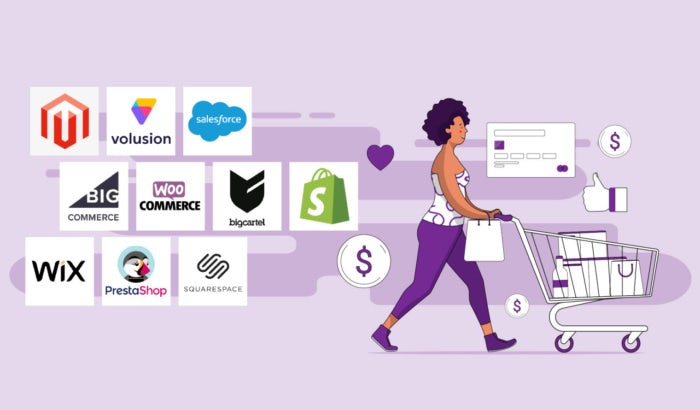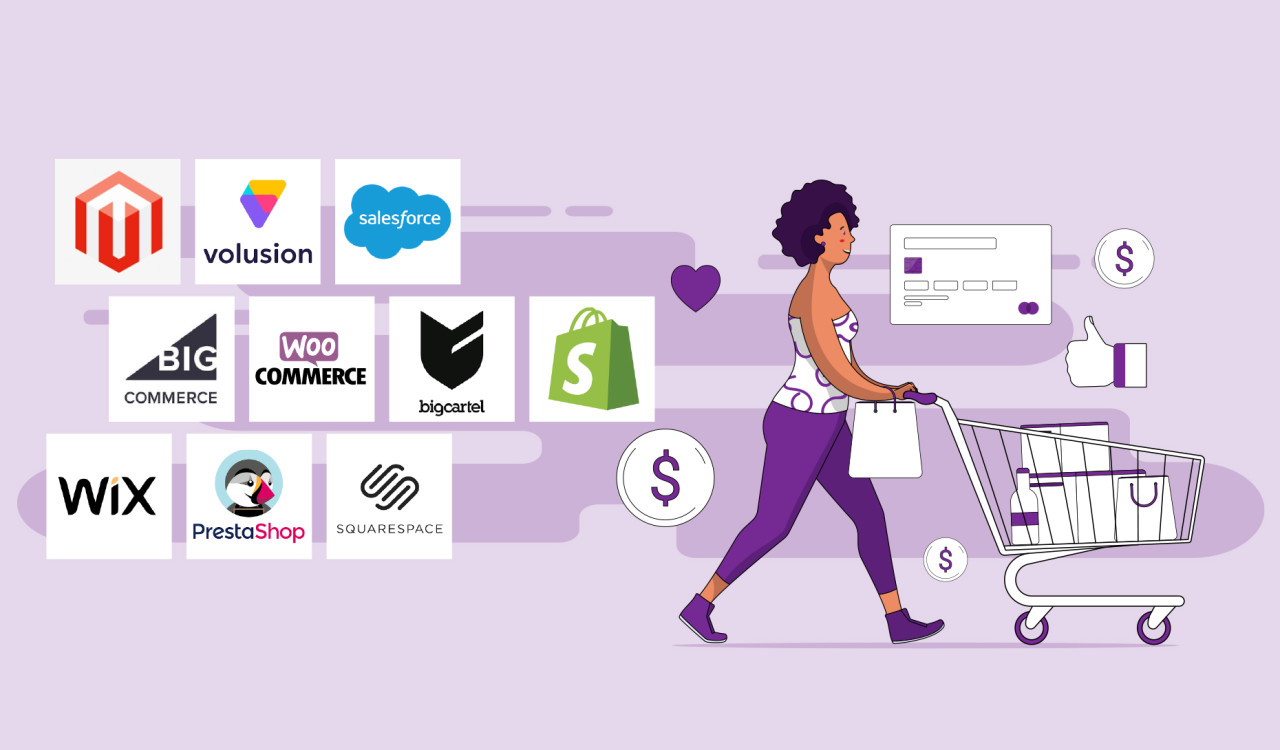As of 2020, there are somewhere between 12 and 24 million ecommerce stores operating on the net, spread out across the best ecommerce platforms. Anything you want, you can get online… but what if what you want is to become an ecommerce entrepreneur yourself?
There are lots of different reasons to start an online shop. Maybe you’re planning a new business venture to replace your sole source of income. Maybe the plan is to start a side hustle with room to grow into your full-time source of income. Maybe you want to keep your day job, but use the ecommerce business as a hobby. Or maybe you already run a brick-and-mortar business and ecommerce is just another expansion, like opening up a second store, except online.
 Shop around to find the best ecommerce platform for your online store. Illustration by OrangeCrush
Shop around to find the best ecommerce platform for your online store. Illustration by OrangeCrush
As you learn about different ecommerce platforms and their capabilities, think about how you’ll need (or not need) these capabilities as you grow your business. Your store’s current and future needs will drive its design, as will the technical specs and limits of the platform you’ve chosen. To help you make the right call, we took a close look at ten of the best ecommerce platforms on the internet.
Hosted? DIY? Licensed?
—
Ecommerce platforms fall into three distinct categories:
Hosted
Licensed
DIY
The difference between these three categories is where they’re hosted. There are other differences too, but hosting is the most divisive one.
 Here is an example of a custom Squarespace design. Web design by blue-eyed-barbarian
Here is an example of a custom Squarespace design. Web design by blue-eyed-barbarian
The first category, hosted platforms, handle everything for you (yes, even hosting). With a hosted ecommerce platform, you create an account and build your store using the platform’s store builder. The store is hosted on that platform’s server, and that platform handles everything “techy” for you, like web security and software updates. For an entrepreneur who neither has coding/tech skills nor wants to learn them, a hosted platform is by far the simplest choice.
Within the hosted category, there are two distinct subtypes. First are platforms that enable you to create an independent store with your own look, your own custom domain name and your own rules regarding returns, shipping, payment options and items for sale. Second are platforms where you simply list your products and the platform takes care of the rest, less customization but less effort, too.
This guide deals more with the first category, which includes many of the best ecommerce platforms like Shopify. But if you’re looking for a hands-off way to get your products out into the world, platforms like Etsy or Amazon allow you to create a seller account, upload your products and descriptions, set your your prices and that’s it.
 This website was designed for Shopify. Web design by Hiroshy
This website was designed for Shopify. Web design by Hiroshy
Then there’s licensed platforms, which are way more technical than hosted ones. When you go with a licensed ecommerce platform, you buy store builder software. With the software, you create your store’s pages, then upload them to the server of your choice. The platform provides support, but you’re on your own when it comes to security, hosting and managing your own files. For the tech-savvy entrepreneur (or the entrepreneur with a budget to hire somebody who’s tech-savvy), licensed ecommerce platforms give you the greatest amount of freedom as a store owner.
 And this is an example of a custom WordPress theme. WordPress theme design by JSPDesign
And this is an example of a custom WordPress theme. WordPress theme design by JSPDesign
Last, we’ve got DIY options. Like a hosted platform, this kind of setup often comes with customizable templates and easy-to-use editors. But like a licensed platform, you’re on your own when it comes to finding hosting. This kind of setup works best if you have some tech skills, but you don’t need to be a programmer to create a functional, nice-looking ecommerce shop.
Let’s take a look at your options. Here are the most popular ecommerce platforms for selling online:
1. Shopify
—
First up, we’ve got Shopify. More than 800,000 ecommerce businesses use the Shopify platform, and since its launch in 2004, they’ve made billions in collective sales.
Setting up a store with Shopify is easy. You can buy your domain name right through Shopify and start building immediately. There are more than 60 themes you can use to customize your store, but be aware that some of them cost extra. If you don’t like any of the premade themes, you can also work with a designer from 99designs to create a custom Shopify theme.
Shopify also offers an enterprise-level platform known as Shopify Plus. The difference is the platform’s power: a store built with Shopify Plus can handle more than 10,000 transactions per minute. You pay a lot more for Shopify Plus, but you get a lot more, too. Shopify Plus offers a few features that large-scale store owners might want, including:
A dedicated store launch manager who audits your store to ensure it’s fully compatible with Shopify
A customizable checkout page
Shopify Flow, a tool that creates personalized storefronts for customers based on their previous purchases
A more robust analytics system
Type: Hosted
Price:
Basic Shopify: $29/month
Shopify: $79/month
Advanced Shopify: $299/month
Shopify Plus: starts at $2,000/month
Pros:
Huge community of designers, developers and other store owners who offer solutions and support
Built-in analytics dashboard with a live view option
Lots of plugins and integrations
A comprehensive point-of-sale system that you can use in real-life settings (like a pop-up shop), with tools like barcode readers and receipt printers
Cons:
If you don’t use Shopify Payments, you’ll pay transaction fees
Less customization options compared to other platforms
Recommended for:
Shopify is recommended for small- to medium-sized retailers. It’s not built for any specific industry; you can sell tangible goods as well as digital goods via Shopify’s platform.
Shopify Plus is for large-scale retailers who are already doing thousands of transactions daily.
2. Big Cartel
—
Big Cartel advertises itself as being for artists and makers. If you’re a creative entrepreneur, keep that in mind—Big Cartel was built to accommodate the kind of business you run, with five images per product and multichannel selling options, so your site goes with you to every art show and vendor fair.
Unlike most of the other entries on our best ecommerce platforms list, Big Cartel offers a free option. It’s limited for sure, but if you’re brand-spanking-new to ecommerce and you have a shoestring budget, Big Cartel’s free option might be your best choice. With it, you get a basic setup with premade themes, shipment tracking, sales tax calculations and the ability to sell both online and in person. These are all things you’ll get with a paid plan too, but for a free option, we’d say it’s pretty robust.
Type: Hosted
Price:
Gold: Free
Platinum: $9.99/month
Diamond: $19.99/month
Titanium: $29.99/month
Pros:
Inexpensive
Integrated Google Analytics in paid plans
No transaction fees
Cons:
Few direct add-ons; if you want apps, you’ll need to use (and pay for) Zapier
Limited user support
Lacks many of the features other ecommerce platforms offer
Recommended for:
Independent artists and makers who want a simple way to sell their creations online.
3. Magento
—
Among the best ecommerce platforms on the web, Magento is one of the biggest. Magento actually offers more than an ecommerce site-building tool; the company brings to the table a variety of products for various aspects of launching and operating an ecommerce business, like order management and business insights.
In 2018, Adobe bought Magento and subsequently launched Adobe Commerce Cloud, a rebranded version of what was previously known as Magento Cloud. It’s a cloud-based version of Magento Commerce that gives users access to Adobe’s suite of ecommerce tools like Adobe Marketing Cloud, Adobe Analytics Cloud and Adobe Experience Manager. Adobe Commerce Cloud is Magento’s enterprise-level offering and, according to the BigCommerce blog, launches often have six-figure price tags.
Any kind of ecommerce business can use Magento’s platform, but it has configurations tailored to a few specific industries like fashion, automotive and food & beverage. With one of these setups, you can build a website that provides exactly what customers want from a business like yours, with features like easy mobile ordering for a restaurant.
Type: Licensed
Price:
Magento Commerce: starts at $1,988/month
Adobe Commerce Cloud pricing varies widely according to project scale and individual needs
Pros:
Built-in scalability
Dedicated omnichannel shopping features
You can list a ton of products in your store and process thousands of transactions every hour
Cons:
You need to buy your own hosting—and your own dedicated server is recommended
It’s “bulky,” your site has lots of files to manage and store
Recommended for:
Large-scale operations that need a platform with a lot of horsepower. If you’re a solopreneur, unsure if you’ll turn a profit or just dipping your toes into ecommerce, Magento is probably too much platform for you.
4. WooCommerce
—
WooCommerce isn’t a standalone ecommerce platform; you also need to use WordPress. Don’t worry, WordPress is free—but all your store’s individual components, like your domain name and hosting, are not. The upside is that you’re not locked into buying a domain or hosting from a specific provider, so you’re free to shop around to find the best prices.
WooCommerce is free too, but don’t assume that means running an ecommerce store with WooCommerce doesn’t cost anything. The plugin itself is free, but to run a functional store, you’re going to need additional plugins that can cost anywhere from $25 to $100 apiece. Some themes are free, but more stylish or customized themes cost extra as well. If you’re not tech-savvy enough to do all the backend work yourself, you’re also going to need to hire a developer.
As far as ease of use goes, WooCommerce isn’t as simple to use as a hosted platform like Shopify or Squarespace. But since you’re outside a gated platform like this, there are a lot more ways to customize your store. Unfortunately, those customization options aren’t created equally—you could end up with a buggy, broken or non-secure plugin if you don’t do your homework.
Type: DIY
Price:
Technically free, but the costs for hosting and plugins vary
Pros:
A huge online WooCommerce community, so you can always find support and answers to your questions
Lots of plugins for different ecommerce needs, like dropshipping integration
Cons:
Too many moving parts; it’s WordPress + WooCommerce + a theme + hosting + any plugins you want to use
No centralized support
Recommended for:
Entrepreneurs who are somewhat tech-savvy and don’t have a huge budget to work with. WooCommerce is scalable, so there’s no limit to how many products you can list or how many daily transactions you can process.
5. Wix
—
Wix is perhaps best known as a free website builder, or even for being very easy to use. That extends to Wix’s ecommerce site builder, which comes fully loaded with premade templates, images and backgrounds. Also, Wix ecommerce is partnered with dropshipping platform Modalyst, so setting up dropshipping is super simple.
Wix’s online store builder also includes tools meant for specific types of businesses. For example, if you’re a restaurant owner, you can easily upload your menu and accept reservations through your Wix website. If you’re a musician, you can add a SoundCloud or Spotify music player to your store so visitors can listen to your work before they buy. Regardless of your business type, you can use any of the user-created plugins available in the Wix app store.
But Wix ecommerce isn’t perfect. It’s simple, but simple often means basic—and compared to other platforms, Wix lacks more advanced features like multilingual stores and the ability to accept Apple and Google Pay.
Type: Hosted
Price:
Business Basic: $23/month
Business Unlimited: $27/month
Business VIP: $49/month
Enterprise: $500/month
Pros:
List up to 50,000 products
Easy-to-use interface
Unlimited bandwidth with every plan
Cons:
Although you can list up to 50,000 products, your site will slow down around 50 products
Sites tend to load slowly in general
Fewer third party plugins than other platforms
Recommended for:
Small to mid-sized stores. Because Wix is an all-in-one solution, it’s a good choice for the less tech-savvy entrepreneur.
6. Squarespace
—
Squarespace is among the best-known website builders, and that popularity lands it among the best ecommerce platforms on the web. With Squarespace, you’ve got everything you need to build your website, like a domain registrar, hosting and a no-coding-skills-required editor, all in one spot.
Like other platforms, Squarespace comes with lots of free website templates (and plenty of paid ones too). You can also use apps and plugins to add functionality to your ecommerce site, but there’s no actual app store with Squarespace. Rather, you’ll be using third-party apps.
Squarespace isn’t a dedicated ecommerce platform, but instead a general website builder that has ecommerce capabilities, so it lacks some of the features the other best ecommerce platforms offer. This means fewer payment gateways, fewer marketing extensions and more features restricted to the higher-tier subscriptions than other platforms.
Type: Hosted
Price:
Online stores basic: $30/month
Online stores advanced: $42/month
Pros:
Unlimited bandwidth and storage
Easy integration with apps like MailChimp and Google Maps
Cons:
No phone support
No professional analytics reports
Recommended for:
Entrepreneurs who are new to ecommerce and want a relatively basic, all-in-one platform without shelling out a lot of money.
7. SalesForce Commerce Cloud
—
Of all the best ecommerce platforms, SalesForce shares the most in common with Magento. Both are companies that offer multiple licensed ecommerce products, rather than being one store-building platform. SalesForce, like Magento, also offers a customer relationship management (CRM) platform as well as marketing and sales products.
Specifically, SalesForce Commerce Cloud is SalesForce’s ecommerce platform. There are two distinct products: one for B2B businesses and one for B2C businesses. One thing that makes SalesForce Cloud Commerce unique is its approach to pricing: instead of charging users a flat monthly fee, SalesForce takes a commission from each user’s sales. This can make running a store with SalesForce inexpensive… if you aren’t moving much inventory. On the flipside, it can get expensive if business is booming.
Type: Hosted
Price:
Varies widely; dependent on your store’s gross merchandise volume (GMV)
Pros:
Hosting is included in your plan
SalesForce offers other products you can use to manage your business more effectively
You can run multiple unique stores from one backend interface
Cons:
No premade templates
Smaller developer community than other platforms
Recommended for:
Any entrepreneur who needs a robust, everything-included ecommerce solution with a lot of integrations, a lot of room to scale and no need to touch code.
8. BigCommerce
—
Although it’s on the pricier side, BigCommerce compensates with more advanced features at the basic level than some other platforms have at higher tiers (or at all!), such as automated image optimization, unlimited staff accounts, unlimited bandwidth and professional analytics reporting.
Like other ecommerce platforms, BigCommerce’s service is available in tiers, but unlike the others, each of BigCommerce’s tiers have sales limits. For example, BigCommerce Standard’s sales limit is $50,000 annually. If you sell more than that, you have to upgrade to BigCommerce Plus regardless of whether you actually want or need the upgraded tools available at that tier.
BigCommerce stands out as the only one of the best ecommerce platforms that makes it possible to sell tangible goods, digital goods and services without integrating an outside app. Other platforms on our list, like Big Cartel, can be set up to sell tangible and digital goods, but if you’re selling a service, BigCommerce is your best bet.
Type: Hosted
Price:
BigCommerce Standard: $29.95/month
BigCommerce Plus: $79.95/month
BigCommerce Pro: $299.95/month
BigCommerce Enterprise: varies
Pros:
Ability to sell on multiple social media platforms like Facebook and Pinterest
Customizable code; you can design a site without ever touching the code or you can alter the theme’s HTML and CSS to suit your exact needs
Strong SEO tools
Cons:
Only 12 free themes
Not as simple to use as other ecommerce builders
Recommended for:
Businesses that have unique needs or needs that require advanced features. There’s a lot under the hood with BigCommerce, making it the ideal solution for a large or rapidly growing business.
9. Volusion
—
Next up, we’ve got Volusion, another hosted platform that offers customizable store templates, add-ons and integration with third-party services and products.
One of the specific features Volusion provides is Quick Wins: affordable services that help you get your store up, running and optimized for profit. Among the services Quicks Wins offers are Google Analytics training, Facebook Pixel installation, SEO-friendly URLs and PPC ad copywriting. Beyond these, Volusion offers larger scale professional services too, like custom logo and brand kits.
Type: Hosted
Price:
Volusion Personal: $26/month
Volusion Professional: $71/month
Volusion Startup: $161/month
Volusion Business: $269/month
Volusion Prime: Varies
Pros:
Lots of built-in features, like variant pricing and advanced shipping options—there’s less need for additional apps or plugins
Unlimited products and storage available even on the lowest tier
Easy integration with Ebay and Amazon Marketplace
Cons:
Sales limits at each level
Only seven free themes
Recommended for:
Any entrepreneur who needs personalized support getting their store up and running. When you need help branding, blogging, developing a newsletter strategy or navigating the world of ecommerce via social media, Volusion’s team is there for you.
10. PrestaShop
—
The last of our picks for the best ecommerce platforms, PrestaShop has the quite a lot in common with WordPress. Like WordPress, PrestaShop is an open-source program that’s completely free to use. Similarly, like WordPress, the PrestaShop community is full of custom-made templates to download and plugins to install to improve your shop’s functionality. The main difference between PrestaShop and WordPress is that PrestaShop was created specifically for ecommerce, whereas WordPress is a more generalized platform that can be outfitted for ecommerce.
It’s impossible to estimate what it costs to run your store with PrestaShop because you’ll need to buy the plugins your store needs and a template that works for your industry and brand. The costs for these vary widely, so we recommend taking a look at the PrestaShop Addons marketplace and sketching out a rough budget of what the setup will cost before you commit.
Although you have to buy your own hosting, PrestaShop is partnered with two hosting providers, so setting up hosting is a relatively straightforward process. Similarly, PrestaShop offers customer support plans, website audits, optimization services and training on how to use the platform—but you have to pay for them.
Type: DIY
Price:
Technically free, but expect to pay for plugins, hosting and a template.
Pros:
It can be a budget-friendly option for users who don’t need a lot of add-ons
Large developer and user community
Flexible platform with lots of customization options
Cons:
It’s free to download, but the add-ons are costly… and for most users, critical to a functioning ecommerce site
Everything is on you—hosting, add-ons, integration and security
Limited scalability
Recommended for:
An entrepreneur who’s comfortable DIY’ing their website and wants the freedoms that come with the DIY approach. PrestaShop has lots of add-ons and customization options, but they’re best suited for users who aren’t afraid to tool around and get their hands dirty.
Shop around for the best ecommerce platforms
—
When you’re choosing the right platform for your ecommerce store, you’ve got a lot of considerations to make. One way to make it easier for yourself is to write a list of what you need in a platform, like built-in hosting or easy dropshipping integration, and then see which platforms check off the most boxes.
And if you pick a platform and find it’s not working out for you, don’t fret—you can always migrate your site to another one.
Regardless of which platform you choose, your store needs to look great and fit your brand. Otherwise, visitors won’t become buyers. Once you have a platform, find an ecommerce designer who’s got experience creating great-looking stores on that platform.
Want to create the perfect ecommerce website?
Work with our talented designers to make it happen.
Let’s go!
The post The 10 best ecommerce platforms for selling online—and how to pick the right one appeared first on 99designs.
Read more: 99designs.com
